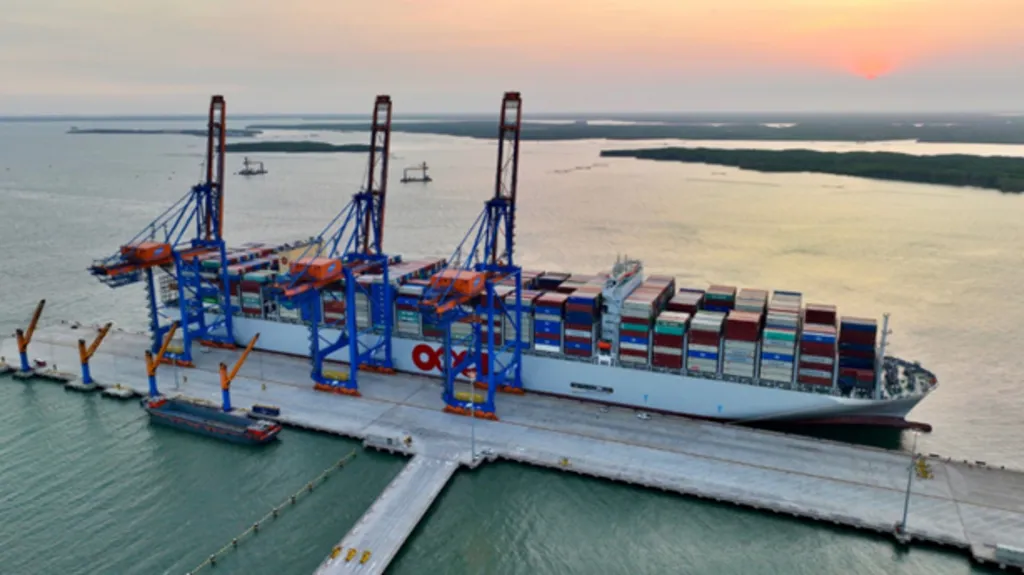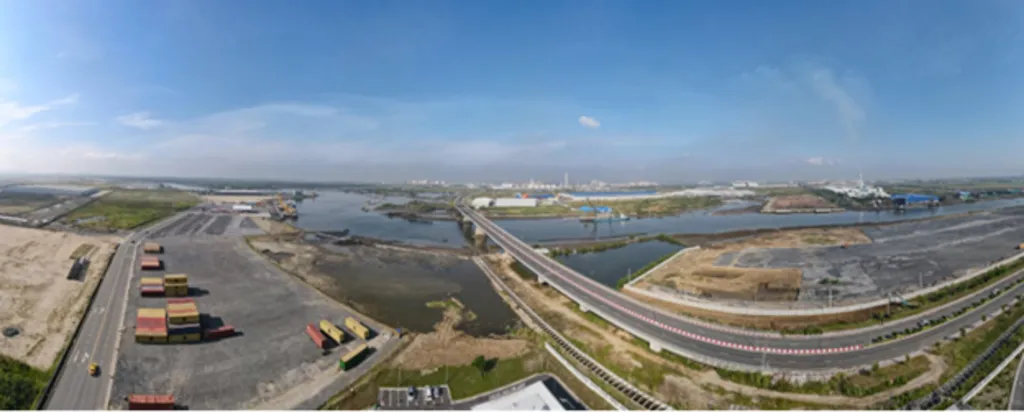 Brandinfo
Brandinfo

In Resolution 05/NQ-HĐND dated May 31st 2023, the provincial authorities identified seaport-logistics as one of the four pillars to develop the local economy. According to the document, during the 2026-2030 period with the vision towards 2050, the province will concentrate on enhancing the national seaport's role, developing and modernising it into a major international transshipment port. This gateway is closely linked to the Moc Bai – Ho Chi Minh City – Bien Hoa – Vung Tau and the trans-Asian economic corridor and is considered as the maritime gateway of the Southeast Asian region.
 |
| The world's largest container mega-ship, OOCL Spain, with a capacity of 24,000 TEU, docks at Gemalink Port – Photo Credit: Gemalink. |
The CM-TV seaport cluster has the advantage of being a natural deep-water port, being sheltered from wind and waves, staying near international shipping routes and being capable of accommodating big cargo vessels. Right from the early days of surveying and planning, international experts said that this region fulfilled necessary conditions to establish and develop a national and international deep-water system.
Currently, the CM-TV port cluster is one of Vietnam's two national special ones. It has modern infrastructure and is capable to accommodate vessels with capacity up to 250,000 tonnes (approximately 24,000TEU). This is the only port cluster in Vietnam that has direct mother vessels to Europe and the Americas, ensuring the highest frequency of voyages to the United States in Southeast Asia. This port cluster has connected to about 35 sea routes, in which there are 9 intra-Asia routes, 21 routes to the Americas, and 5 routes to Europe. From the port, it takes goods about 16 days to reach the United States and 21 days to reach Europe.
The CM-TV port cluster has attracted many world class maritime groups such as United States’ SSA Marine, Singapore’s PSA group, Denmark’s APMT, Hong Kong’s Hutchison Port Holding, Japan’s Mitsui O.S.K line and France’s CMA-CGM, which are all participating in investment and exploitation efforts.
BR-VT province’s determination
Despite its huge potential, the port has not had the expected development. Experts point out that in order to make the CM-TV Port become an international transshipment port of regional and global stature, BR-VT must build long-term plans. However, at first, bottlenecks related to the port connectivity infrastructure, especially the post-port logistics infrastructure like distribution centres, depots for trucks, empty containers and dry ports, should be addressed. Moreover, it is necessary to upgrade and dredge waterways to facilitate the entry of large vessels into the port. Other maritime services like customs, inspection, financial and insurance should also be synchronized.
Currently, the province is concentrating all resources on resolving the bottlenecks and taking advantage of its strengths to realize the target of making CM-TV Port an international transshipment port of global stature in the near future.
 |
| BR-VT province is striving to synchronise the port connecting transportation system (A corner of dry port Phu My – Photo: Le Ngan) |
The province has built up a comprehensive transportation network to integrate with its national, regional and intra-provincial transportation system with all transportation forms, including roads, airways, maritime routes, inland waterways and railways. It is cooperating with other key projects like Bien Hoa – Vung Tau highway, the Phuoc An Bridge connecting the Cai Mep - Thi Vai Port complex, the HCM City Ring Road 4, dredging maritime routes from Vung Tau to Thi Vai and conducting research on launching the Bien Hoa – Vung Tau railway line.
Furthermore, the province is concentrating on developing logistics centres on the coastline economic corridor. It has carried out a plan to build a free trade zone integrated into the seaport system in the Cai Mep Ha region and form a complete industry–service ecosystem. Land is being allocated to attract global industrial groups to move part of global supply chains to the province.
The province is planning to develop its logistics infrastructure attached with the commercial and IT infrastructure that can meet necessary conditions to apply artificial intelligence (AI) and high-tech connection. Furthermore, it is making efforts to form close connection between the national seaport system and the Long Thanh International Airport. The logistics service ecosystem is being set up with the following features: storage system, dry port, logistics centre, warehouse systems, shipping agency offices and maritime brokerage agents.
At the same time, BR-VT is trying to reform administrative procedures and digitalize public services to make favourable conditions for the companies to enhance the operational and management efficiency of the CM-TV port system.




